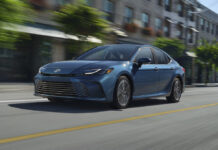
The 2021 Toyota Mirai is upon us (well, those in California at least), and boy is it a huge departure from the old car. Gone is the quirky styling, and in its place we see a hydrogen-powered car that’s altogether more conventional. The new Mirai is a rear-wheel drive sedan built on the same GA-L platform as the Lexus LS sedan. Not only is that unique for the Mirai, but a RWD layout is unique for the fuel cell market as a whole. At the moment, other FCEV models in production — few that they are — are front-wheel drive. In the video below, our friend Alex from Alex on Autos takes a closer look at the updated model along the lines of the Lexus LS and his own hydrogen fuel cell car, the Hyundai Nexo.

2021 Toyota Mirai: The details
So what’s new with the 2021 Toyota Mirai, apart from the platform? The styling is definitely the most obvious change, but that comes with dimensional changes as well. The new model is over three inches longer, nearly three inches wider and 2.5 inches lower in height than the car it replaces. The new model is 176 pounds heavier, but Toyota did balance that weight 50:50 across the axles, so it’s not as nose-heavy as the old Mirai.
Underneath, the new car packs a fuel stack that is 20% smaller and 50% lighter than the outgoing model. Toyota’s engineering there allowed the Mirai to house the stack entirely under the hood, allowing the change to a rear-wheel drive layout. All in all, the 2021 Toyota Mirai manages 182 horsepower and 221 lb-ft of torque from its powertrain. As Alex points out, the hydrogen fuel cell can’t provide all that energy when you’re really hammering it, so the new Mirai does still have a lithium-ion battery as well. That’s also about five pounds lighter than before, and has a higher capacity than the nickel-metal hydride battery in the first-gen Mirai. The smaller 6.5 Amp-hour battery fits between the rear seat and the trunk, meaning it can still store 2-3 golf bags, according to Toyota.
The 2021 Toyota Mirai can manage an EPA-estimated range of 402 miles, a 30-percent increase over the old car.
What about the tech?
On the tech front, the 2021 Toyota Mirai also brings the latest and greatest from the automaker’s recent offerings. That includes Toyota Safety Sense 2.5+ with full speed radar cruise control, automatic emergency braking and lane keep assist. Blind spot monitoring is also standard on the new Mirai, whether you opt for the lower XLE or the top-end Limited trim.
The center stack boasts a 12.3-inch infotainment display similar to what you get on the new Highlander, as well as an 8-inch gauge cluster. A JBL 14-speaker premium audio system comes standard on both trims, as does Android Auto, Apple CarPlay and Amazon Alexa support. A Bird’s Eye View camera is available as an option on the XLE, and comes standard on the Limited. On top of the standard heated and power-adjustable front seats you get with the XLE, the 2021 Toyota Mirai Limited also offers ventilated front seats, heated rear seats, three-zone climate control, ambient lighting and a panoramic roof.
But with prices starting near $50,000 ($66,000 for the Limited), is it worth springing for the new Mirai? It comes in substantially lower than the outgoing model, albeit you can still just buy it in California. As it stands, that’s the only U.S. state that really has any infrastructure to support hydrogen at the moment. However, if you are able to actually buy it, you do get $15,000 worth of free hydrogen fuel. Lease deals on the Mirai start at $499 a month for the XLE and $549 a month for the Limited.
Check out more below and let us know what you think in the comments:

























